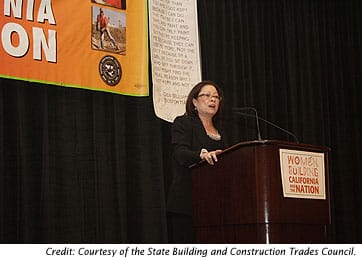
 (WOMENSENEWS)–When Elizabeth Fox, 44, was completing her electrician apprenticeship, male coworkers hid their work from her so she couldn’t see what they were doing. That made it difficult to learn how to use the trade’s tools, especially since they didn’t fit her hands.
(WOMENSENEWS)–When Elizabeth Fox, 44, was completing her electrician apprenticeship, male coworkers hid their work from her so she couldn’t see what they were doing. That made it difficult to learn how to use the trade’s tools, especially since they didn’t fit her hands.
Twenty-four years later, she has punctured cartilage in her shoulder, a crushed ulna nerve canal in her elbow, tendinosis in her forearm, atrophy in her arm, meniscus damages and has had two knee surgeries.
"I want to make sure that women in the business don’t make the same mistakes I did," Fox said. "Women need to work smarter, not harder."
Professional grade work tools are made to fit men’s hands. Even those advertised as being ergonomically safe are only so for the average man’s hands and body.
"Tools just don’t fit women’s bodies," said Mary Watters, director of communication for the Center for Construction Research and Training, a construction industry research, training and service nonprofit based in Silver Spring, Md. "Even their gloves don’t fit. It raises the risk that tools can slip, and to compensate for tools and gloves not fitting, women have to apply more pressure than do men. Repeating motions day in and day out can cause severe injury."
Fox has done research, while studying at The National Labor College in Maryland, with chiropractors, physical therapists and orthopedic surgeons on the dangers of working with ill-fitting hand tools. She says tools that don’t fit properly can trigger pressure points, damage blood vessels and lead to injury.
Low Numbers Raise Risks
In 1970, 1.2 percent of construction trade employees were women. In 2000, they made up 2 percent of construction trades.
Françoise Jacobsohn is project manager of the Equality Works program at Legal Momentum, the country’s oldest legal defense and education fund for women, with headquarters in New York City.
She said women’s low numbers raise their on-the-job risks.
Jacobsohn said better working conditions for tradeswomen depend on increasing the number of women in apprenticeship programs until women reach the critical mass needed to make wide-reaching changes in the sector.
"Most women don’t want to litigate," said Jacobsohn. "Women are willing to put up with a great deal of injustice to keep working. They know if they press issues, they will be shoved off of sites. There are real repercussions to speaking out in the trades."
Francine A. Moccio, author of the 2009 book "Live Wire: Women and Brotherhood in the Electrical Industry" agrees that there are repercussions, even without speaking out.
"There’s a lot of hazing that goes on in the trades. I’ve heard many, many stories . . . of men setting women up to get hurt, letting them get electrocuted, urinating on their toolboxes," she said.
Moccio said worksite conditions are suffering from the economic downturn. "Contractors aren’t really paying attention to safety. They’re competing for jobs and don’t want to go over budget. And during the recession property values have dropped so much while building costs are still high. So they cut corners and costs everywhere they can."
Laura Boatman is project coordinator for the State Building and Construction Trades Council, a statewide labor organization, based in Sacramento, Calif., that held the first national conference for tradeswomen in May. She says women’s on-the-job training is hindered by contractors who consistently shy away from hiring them.
"Women are given tasks that they aren’t trained to do," Boatman said. "And often will be assigned tasks that two men will handle . . . Because they want to prove themselves, they will do it and be injured."
Lack of Bathrooms
Lack of onsite bathrooms is also a large matter of contention for women in the trades.
Federal sanitation standards require employers to provide their employees with separate toilet facilities for each sex.
Boatman said these are often missing on actual worksites and female workers sometimes report having to jog 20 minutes to reach a facility. Jacobsohn added that a lack of or inadequate facilities cause frequent bladder infections in women.
Local unions are urged to establish joint safety and health committees, according to Carolyn Williams, human services director of the International Brotherhood of Electrical Workers. Unions are responsible for maintaining records of on-the-job accidents and injuries and reporting "significant accident trends" to the Occupational Safety and Health Administration and other government agencies. The OSHA Act of 1970 requires employers to provide employees with a place of employment that is free from known hazards causing or likely to cause death or serious physical harm to employees.
While OSHA regulations contain "hundreds of statues on safety and sexual harassment," enforcement of OSHA regulations has been weakened over time, Moccio said.
The leading cause of worksite fatalities in the construction trades is falling from a dangerous height. But standard fall harnesses aren’t manufactured to fit women.
"They cut them right in the breasts," said Debra Chaplan, director of special programs for the State Building and Construction Trades Council. "Some jobsites have started using ones that form a triangle around the chest, but that just opens women up to even more sexual harassment."
Unless there is a major incident, a complaint won’t get any action taken on it, even if it is a federal safety standard, Chaplan said.
"There are just not enough people to make it happen," she said.
Would you like to Comment but not sure how? Visit our help page at https://womensenews.org/help-making-comments-womens-enews-stories.
Would you like to Send Along a Link of This Story?
https://womensenews.org/story/entrepreneurship/110619/female-tradesworkers-run-special-safety-risks
K. Aleisha Fetters is a freelance writer based in New York City.
For more information:
Legal Momentum:
http://www.legalmomentum.org/
The Center for Construction Research and Training:
http://www.cpwr.com/
State Building and Construction Trades Council:
http://www.sbctc.org/


